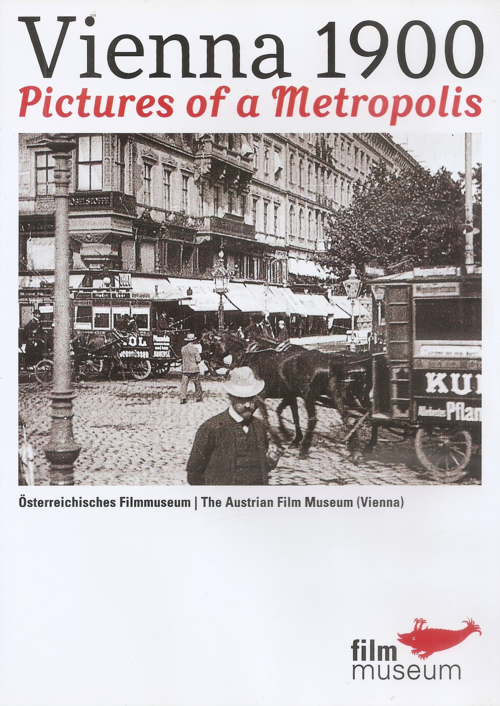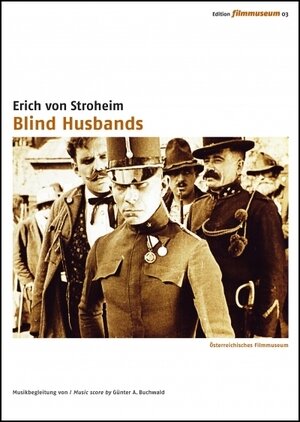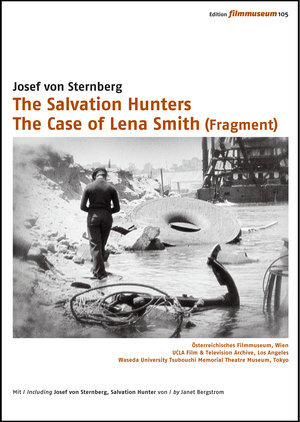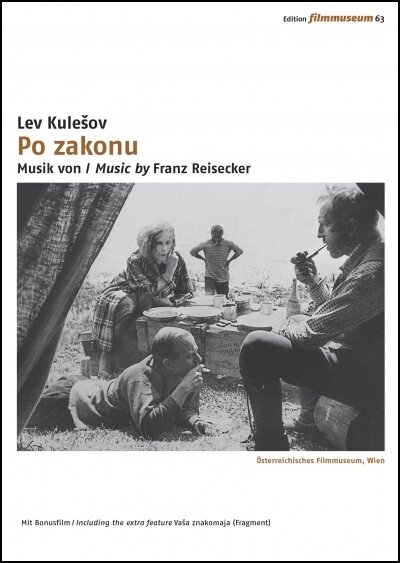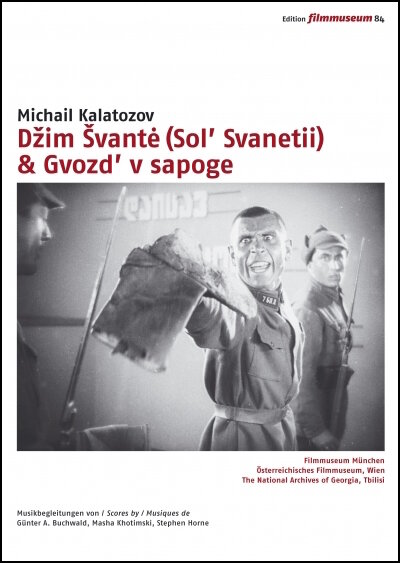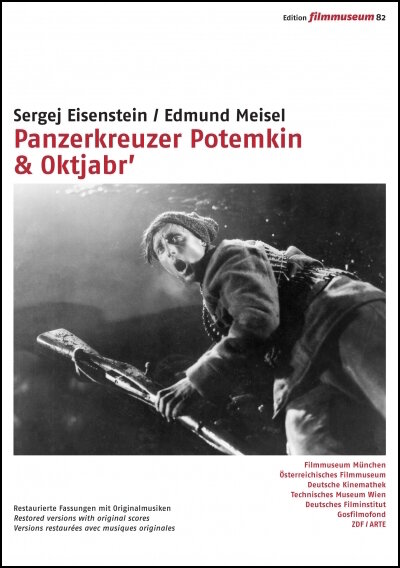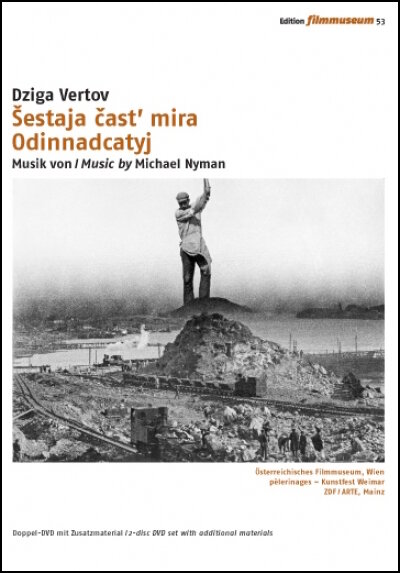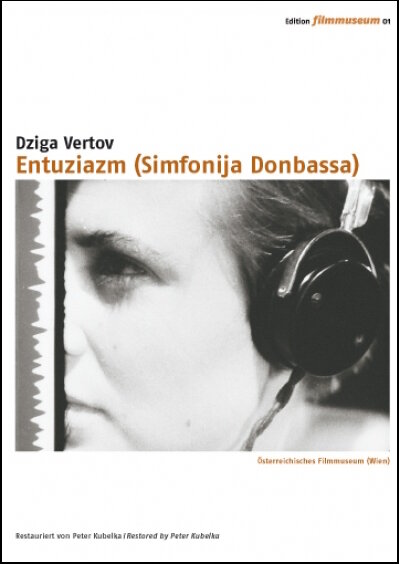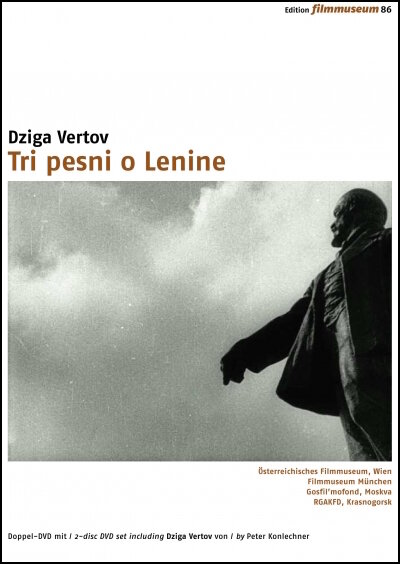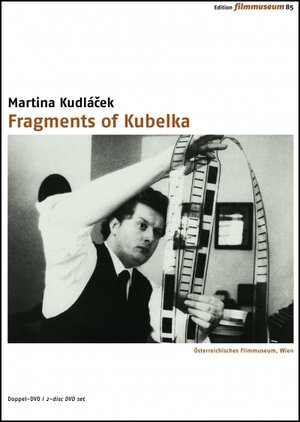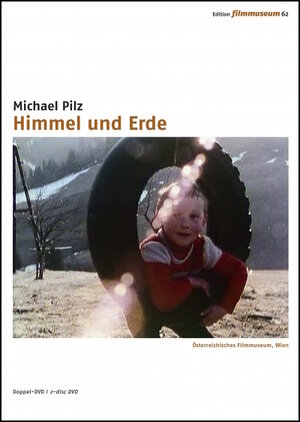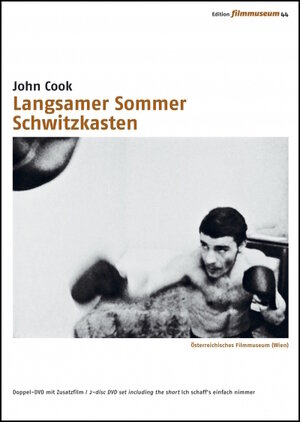RECAPPING GME STREAMLINE'S PRESENTATION OF FILMS FROM EDITION FILMMUSEUM - VIENNA AVAILABLE AS DVD/DSL BUNDLES
/This past season GME Streamline was pleased to present a curated collection of DVD publications from Edition Filmmuseum - Vienna, all of which we have now made available as DVD/DSL bundles. These works comprise early cinema actualities shot in Vienna at the turn of the 20th century, classic silent American fiction films, monumental works of Soviet cinema, American experimental narratives, Austrian independent films, and cinema from Thailand in the postmodern era. This array of works comprise films by directors James Benning, Josef von Sternberg and Eric Von Stroheim (US), Dziga Vertov , Lev Kuleshov, Sergei Eisenstein, and Michail Kalatozov (USSR), and Martina Kudláček, Michael Pilz, and Canadian transplant John Cook (Austria), as well as Apichatpong Weerasethakul (Thailand). Ideal for academic study and research, these DVD Editions contain multitudes of extras as well as bilingual texts in English and German about the respective films and their filmmakers.
The Austrian Film Museum in Vienna was founded in 1964 by Peter Konlechner (1936–2016) and film artist Peter Kubelka (b. 1934). From its outset, the principal aims of the institution were the high-quality preservation and public presentation of film, as well as reaffirming the two important roles of cinema in society: as the most important form of artistic expression in modernity and as the chief historiographical source of the 20th century.
◊
From the silent era, we present early actuality films of Vienna (1906-1916), as well as classics of American silent cinema, Erich Von Stroheim’s BLIND HUSBANDS (1919) and Josef Von Sternberg’s THE SALVATION HUNTERS (1925).
It is not the canonical “Vienna films” - the big budget romances and operettas of the 1930s and 1950s - that provide the focus for the DVD entitled VIENNA 1900. PICTURES OF A METROPOLIS, but rather a collection of rare film documents from the collection of the Austrian Film Museum. These works and fragments were saved from oblivion by the Film Museum's archivists, and offer vivid glimpses of urban life in Vienna during the last decade of the Empire. The coexistence of technological modernization and traditional imperial customs, of spectacle and the vernacular pervades these pictures, shot by international crews and viewed by movie theatre audiences throughout the Austro-Hungarian Empire and most of Europe. The films were uncovered and digitized in the course of “Film. Stadt. Wien”, a research project exploring the relationship of cinema and urban space from a historical perspective. The selection is dedicated to presenting the vernacular landscapes of street life, traffic, pastime and festivities. The last two films, the compilation THE EMPEROR ON FILM (c. 1910 – 1916) and THE FUNERAL PROCESSION FOR FRANZ SCHUHMEIER (1913), relate to the politics of the era, juxtaposing rare shots of the Imperial family with a newsreel item demonstrating the rise of the suburban working class and the dawn of the republic. (Seventy years later, in VIENNAFILM 1896 – 1976, Austrian avant-garde filmmaker Ernst Schmidt, Jr. created his subjective collage of Viennese life, using a combination of found footage and newly-shot material).
BLIND HUSBANDS, Erich von Stroheim's 1919 directorial debut, is considered a canonical film of American silent cinema. Set in the alpine scenery of South Tyrol, a menacing Austrian officer (played, of course by Von Stroheim himself) seduces a neglected young wife, only later to fall to his death in a climbing accident. This film still fascinates audiences through its precise visual language and its moral ambiguity. The film is presented in its gorgeous tinted Austrian release version, DIE RACHE DER BERGE (BLINDE EHEMÄNNER) / THE REVENGE OF THE MOUNTAINS (BLIND HUSBANDS), featuring German language inter-titles. This edition represents the longest and oldest version available today. Extras include additional materials from the Austrian Film Museum's Stroheim collection as well as a ROM section with materials on Stroheim and the film.
Described both as the first truly independent American feature film made outside the studio system, as well as the first feature-length avant-garde movie, THE SALVATION HUNTERS (1925) was produced on a shoestring budget by the actor George K. Arthur. It was shot in and around San Pedro, California. Sternberg was the auteur on this film, who was responsible for the direction, writing, art direction, and editing. Chaplin’s support for the film got it distributed through United Artists.
Sternberg spun the necessity of a low budget into a virtue: the film faithfully captures the grit of the “lower depths” milieu in its story of an impoverished young woman striving to make a better life with her naïve boyfriend, despite being surrounded by men who would exploit her. The film reveals Sternberg, under the influence of Stroheim, rejected the sentimental melodrama of D.W. Griffith in favor of an almost raw naturalism, fascinated with corruption and abasement while also exploring the poetically charged and evocatively contrasting mise-en-scene. Sternberg transformed the nether realms of human experience into worlds of picturesque poetry, where décor stands in for society, costume is character, and emotions are phenomena of pattern and light. Bonus features on this DVD include the only existing fragment of von Sternberg’s THE CASE OF LENA SMITH (1929), as well as a video essay by film scholar Janet Bergstrom about THE SALVATION HUNTERS.
◊
The Vienna Filmmusum has developed a major focus on collecting, preserving, and studying key cutting edge works of Soviet cinema. A special focus has been on the work of Dziga Vertov. Complementing the DVD editions of Vertov’s work, we also release films by his compatriots Lev Kuleshov, Mikail Kalazatov, and Sergei Eisenstein.
BY THE LAW (1926), Lev Kuleshov's legendary “constructivist western”, was one of the most popular films of its time and is now considered a masterpiece of Soviet Cinema. Adapted in 1926 from the Jack London story, “The Unexpected”, BY THE LAW tells the story of a group of prospectors in the Yukon who, after a gold strike and two murders, find themselves faced, in the midst of horrific ice and darkness, with an existential crisis. Aleksandra Khokhlova, the main collaborator and partner of the director, portrays Edith, the unusual female lead. The greatness of BY THE LAW stems from its very minimalism. It can be viewed as a formalist action film, a Western psychodrama or an experimental study in bigotry. There is as much in BY THE LAW of the silent Westerns of John Ford as there is of Erich von Stroheim’s GREED (1924) and Charles Chaplin’s THE GOLD RUSH (1925).
The Georgian-born filmmaker Michail Kalatozov (1903-1973) is best remembered for directing some of the most innovative and successful Soviet films of the 1950s and 1960s – especially THE CRANES ARE FLYING (1959), LETTER NEVER SENT (1959), and I AM CUBA (1964). Kalatozov’s cinematic career began in 1923, which corresponded to the Soviet regime’s growing vision of cinema as a powerful propaganda tool. He came to the new Georgian film studio in the capacity of a driver, where he met Lev Kuleshov (BY THE LAW), one of the founders of Soviet cinema. Kuleshov, an avid lover of automobiles, found common ground with the young Kalatozov, whose future work would incorporate motion and speed as key stylistic devices. Kalatozov began directing films after progressing to the positions of film projectionist, cutter, editor, actor, cameraman, and screenplay writer.
This DVD edition presents digitally restored versions of two of his pioneering, silent era works (SALT OF SVANETIA, 1930, and NAIL IN THE BOOT, 1932), which were highly controversial in their time but now rank among the finest achievements in Soviet silent cinema. SALT OF SVANETIA is an austere depiction of peasant life in the inhospitable terrain of the Caucasus Mountains. NAIL IN THE BOOT, a biting parable of wartime irresponsibility, chillingly prefigures the later Stalinist purge trials. Günter Buchwald's and Stephen Horne's prize-winning scores and the experimental accompaniment by Masha Khotimshi underline the poetic and expressive visual style of each of these films.
Sergei Eistenstein has long been recognized as one of the greatest filmmakers of world cinema and a master of the montage of collision (between shots). BATTLESHIP POTEMKIN (1925) is considered one of the canonical works of international cinema. Set during the Russian Revolution of 1905, the narrative depicts, in dynamic fashion, the mutiny of the crew of the Battleship Potemkin against the officers of the ship, and the ensuing street demonstrations in Odessa and the massacre of the citizenry by the police. The montage of the runaway baby carriage (The Odessa Steps sequence) is one of the most famously recognized scenes in all of cinema history. OCTOBER (1927, co-directed with Grigori Aleksandrov) is a celebratory dramatization of the Russian revolution in October 1917.
This deluxe 2-disc DVD set presents BATTLESHIP POTEMKIN and OCTOBER in previously unreleased and painstakingly restored versions. POTEMKIN is presented in German-language versions (both silent, from 1926 and sound, from 1930), and OCTOBER features the original release together with fragments from the version distributed in Germany. All editions feature the original accompanying scores by Austrian-born composer Edmund Meisel. The ROM section, in addition to the accompanying bilingual booklet, includes a wide range of rare documents and detailed essays on the heavily influential creative partnership of "kindred spirits" Eisenstein and Meisel.
◊
Sharing with poetry concepts of sound and rhythm through shot and montage via his "Kino-Eye" aesthetic, Dziga Vertov created one of the most innovative and influential bodies of cinematic work and theoretical writings in the history of moving image artistic expression. Vertov’s Kino-Eye attempted “to give [back] the filmic to non-fiction film” as Barbara Wurm notes. Distinct from narrative entertainment cinema, Vertov endeavored to capture what is “inaccessible to the human eye” via his particular montage technique, as well as (in his own words) to “bring men closer to machines.” In his Kino-Eye Manifesto from 1923, Vertov wrote that:
"I am an eye. A mechanical eye. I am the machine that reveals the world to you as only the machine can see it. I am now free of human immobility. I am in perpetual motion. I approach things, I move away from them. I slip under them, into them. I move toward the muzzle of a race horse. I move quickly through crowds, I advance ahead of the soldiers in an assault, I take off with airplanes, I fall on my back and get up at the same time that the body falls and gets up. This is what I am, a machine that runs in chaotic maneuvers, recording movements one after the other, assembling them in a patchwork. Freed from the constraints of time and space, I organize each point of the universe as I wish. My route is that of a new conception of the world. I can make you discover the world you did not know existed.”
The poetic travelogue A SIXTH PART OF THE WORLD (1926) and the “visual symphony” THE ELEVENTH YEAR (1928) mark the beginning of Dziga Vertov’s most creative period, which peaked in the canonical film MAN WITH A MOVIE CAMERA (1929) (This film is available from GME in DVD format only, published by Flicker Alley). A SIXTH PART OF THE WORLD employs a travelogue format to depict and unite the Soviet people in remote areas of the USSR, so as to emphasize the wealth of the Soviet land. Shot in the Ukraine, THE ELEVENTH YEAR focuses on industrial production. Both films were intended to unify the sprawling country and promote the construction of socialism in the USSR.
Dziga Vertov's ENTHUSIASM: SYMPHONY OF THE DONBASS (1930) is considered a masterpiece of early sound film and of Soviet avant-garde cinema. Dealing with the Five Year Plan of the late 1920s, it was praised by artists like Charlie Chaplin, was subsequently forgotten, and rediscovered by the avant-garde movement of the 1960s. This 2-disc edition presents the film, for the first time on DVD, in two versions: the print preserved in the former Soviet Union's Gosfilmofond as well as Peter Kubelka's fascinating restoration which - by re-syncing image and sound - allows the viewer to experience what Vertov considered the new language of sound cinema.
THREE SONGS OF LENIN, (1934/1935) presents Vertov’s homage to Vladimir Lenin, the founder of the Soviet Union. This 2-disc set presents the earliest surviving versions of this movie - the 1938 silent and sound reissues of the film's original 1934 sound and 1935 silent releases, which were previously unavailable in digital form. The challenging production and exhibition circumstances surrounding this film, due in great part to the shifting politics within the Soviet Union, are meticulously recounted by historian Adelaide Heftberger in the bilingual booklet accompanying this DVD edition.
Also included are the two Lenin-themed editions of Vertov's Kino-Pravda newsreel series from 1925, as well as a 1974 feature-length TV documentary about Vertov by Austrian Film Museum co-founder Peter Konlechner.
◊
James Benning is one of the foremost global proponents of the experimental narrative form and of the structural film since the mid-1970s. A main focus of his work is an interest in American landscapes. In long sequences influenced by still photography and early cinema, Benning takes a meditative look at nature in its archaic state, and at the interventions of human technology. His movies consist of long, meditative takes set against sound landscapes. GME is proud to present 14 of James Benning’s films comprising 6 DVD editions, as well as CIRCLING THE IMAGE (2003), a documentary on Benning’s meticulous investigation of landscape locations, camera position, and shot duration.
Benning’s films are focused on seeing. About his work he has stated, "since I started making films, I've always tried to open a new narrative space from the juxtaposition of sound and image, or text and image - how the spectator experiences them, how they quote each other.” Benning's use of duration reflects his accord with Henry David Thoreau's passage from Walden that “No method nor discipline can supersede the necessity of being forever on the alert. What is a course of history, or philosophy, or poetry, no matter how well selected, or the best society, or the most admirable routine of life, compared with the discipline of looking at what is to be seen?" GME will be presenting a follow up release with more details about these films by James Benning.
◊
With his debut feature, MYSTERIOUS OBJECT AT NOON (2000), acclaimed Thai filmmaker Apichatpong Weerasethakul expertly blends cinematic fact and fiction in a manner that continues to defy both easy categorization and comparison. A low-fi "genre bender," independently produced on a shoestring budget and subsequently endangered by neglect, this film has now been painstakingly restored by the Austrian Film Museum and the Film Foundation from the best surviving elements. This DVD edition also includes 3 bonus films by the director, THIRDWORLD (1997), WORLDLY DESIRES (2005) and MONSOON (2011).
Shot in fits and starts on a minuscule budget, MYSTERIOUS OBJECT AT NOON was modeled on the Exquisite Corpse (add-an-element structure) famous from French surrealism, in which drawings or texts are passed from person to person to elaborate upon, with the original materials hidden so that each addition does not adhere in any logical or predetermined way, resulting in a collective, randomly assembled piece. In MYSTERIOUS OBJECT AT NOON, Weerasethakul travels with a film crew across Thailand and interviews ordinary citizens so as to add their own words to an evolving story about a boy and his teacher.
According to critic and programmer James Quant, “with its source in Thai popular culture and American documentary and experimental cinema, [it is a] perplexing, and exhilarating conflation of genre (fairy tale, road movie, documentary, horror, science fiction, folk anthropology, musical) and tone (by turn sad, surreal, exuberant, teasing, harsh). Its style manages to be both ramshackle and concatenated: the film’s structure is linear and convoluted at the same time, its title a telling convergence of the unknowable (mysterious object) and the temporally exact (noon). If the precision of the latter turns out to be misleading – time in the film is largely unfixed, in flux, employing historical anachronism and refusing to mark either diurnal specifics or the three-year span it took to make the film – Object’s modus, as is often the case in Apichatpong’s subsequent work, depends on surprise and unreliability, a knowing errancy not only of narrative progression and coherency but also of such formal constituents as sound source and signature, succession of shots, and identification of setting and performer.”
◊
From Austria, we present Martina Kudláček’s FRAGMENTS OF KUBELKA (2012), a study of avant-garde filmmaker Peter Kubelka (one of the founders of the Vienna Filmmuseum), as well as Michael Pilz’s HEAVEN AND EARTH (1982) and expatriate John Cook’s SLOW SUMMER (1976), CLINCH (1978) and I JUST CAN’T GO ON (1972-1973).
Martina Kudláček has developed a unique cinematic legacy by creating discursive, biographical documentaries on experimental cinema personalities. Over the course of her career, she has developed portraits of Alexander Hammid (AIMLESS WALK, 1997), Maya Deren (IN THE MIRROR OF MAYA DEREN, 2002), Marie Menken (NOTES ON MARIE MENKEN, 2006), and Peter Kubelka (FRAGMENTS OF KUBELKA, 2012). Several years in the making, Kudláček’s latest film production runs four times the length of artist Peter Kubelka’s entire cinematic output. According to film historian Tom Gunning,
"Kubelka's films play and work with the flow of time, compressing the continuous now and presence. His films digest the manifold things of the universe: the elemental energies of light and dark; movement and stillness; the life of animals and patterns of landscape; gesture and dance. With another mode of time Kudláček shared with us Kubelka's patient pace of conversation and listening, exploring things that mean so much to the artist: memories, souvenirs, his past and childhood, his home. All these things entered into Kubelka's films, but here they are brought to light and made part of his legacy as teacher and as artist. In perhaps the most sensual sequence, Kudláček shows Kubelka as he prepares, cooks and then eats Wiener Schnitzel. Following rather than compressing the flow of time, we watch as ingredients embrace each other: egg, flour, meat and butter. We see the browning and transformation of these things exposed to fire, listen to their ecstatic metamorphosis. As Kubelka says, food is a metaphor that can be eaten, a meal is a work of art that can be consumed and digested. To digest, Kubelka tells us, is to embrace the universe. FRAGMENTS OF KUBELKA allows us to savor, swallow and digest these lessons."
Michael Pilz's HEAVEN AND EARTH (1982) is an epic documentary, in two parts, about life in the Styrian mountain village of St. Anna. The film is a documentary in the best sense of the word - a meditation on time, on nature and the struggles of man, as well as a record of a lifestyle ceasing to exist. Requiring three years of filming, Pilz did not want to produce an ethnographic, sociological or political film about the people of Sankt Anna. Instead he wanted to communicate his experience of living with these people. The film is an ode of love to these mountain people who live between heaven and earth.
The inhabitants of St. Anna, a mountain village in Austria, live a hard life. They constantly fight with nature to earn their daily keep and to protect themselves from the rigors of the weather. They take after the mountains and glaciers where they live; they are rough and bashful, they prefer to talk to animals, watch the sky and listen to storms rather than engage in long conversations. When they do talk, it is about their work. The things they care for, they care for in silence. Their chores are well integrated into the slow and commanding mountain scenery. In this grand environment endeavors like cutting a tree or killing a hog take on the stature of a pagan or archaic rite. They are not just simple motions one has to go through in order to have wood for the fire or meat for food, but rather a way of identifying with the life cycle.
John Cook was, in his own words, "Viennese by choice". A Canadian fashion photographer, he moved to Vienna in 1968. His films hold a unique position in Austrian Cinema. They are independently produced, featuring a cast and crew of friends and shot on modest budgets. He gave Austrian cinema a taste of the innovative film movements that had flourished in other European countries decades before. This 2- disc set presents restored versions of Cook’s three landmark films produced in the 1970s (two features and a documentary).
SLOW SUMMER was shot on a minimal budget on Super-8 film (a 35mm blow-up was produced for the theatrical release). It positions itself close to the "real" life of its protagonists, a loosely assembled Viennese Bohème characterized by idleness and aimless drifting. One summer scene after the other unfolds in a documentary manner, framed by a film-in-film scenario that makes the construction apparent. The scenes are ruled by intensities those of the characters, but also of the mood of the day. The film is about nothing but then about everything: an image of time, the reflection of mental states that continuously change, and almost in passing it's also a portrait of the city and the life hidden in its alleys.
SLOW SUMMER deals with personal states of mind and the filmmaker's very own existential entanglements (one of which is, crucially, the stranger's view of the semi-familiar city of Vienna) yet aims at an insight that goes beyond the private. This is only one of many self-reflective double entendres in a work rather unusual in Austrian cinema.
In CLINCH, Cook draws the consequences from his previous work. He turns to the working class again, not in a documentary mode but by adapting a novel by Helmut Zenker. CLINCH is no longer a formal hybrid but finds its own modus operandi: neorealism, Vienna style. The film is lyrical, yet down-to-earth, and its tone is precise without crossing the border into grotesque caricature. Above all, CLINCH reveals Cook’s it solidarity with the main protagonist without turning him into a poster child.
Rounding out this DVD edition, I JUST CAN’T GO ON (1972-1973) is a documentary-like portrait of an Austrian couple, an aspiring boxer and a house cleaner. Fleeting footage of each at work and at play is overlaid with voice-over thoughts on the quotidian events that both define and reflect their character. In sum, through these films, John Cook creates an outsider’s portrait of the Austrian society in an intimately presented fashion, which in this broad sense recalls the films of Jonas Mekas (1922 – 2019), a Lithuanian displaced to New York City in 1949, where he chronicled his quotidian existence that was linked closely together with an endless array of cultural figures.



